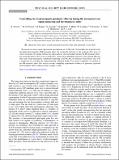Controlling the electromagnetic proximity effect by tuning the mixing between superconducting and ferromagnetic order
View/
Date
12/07/2019Author
Grant ID
EP/I031014/1
EP/J01060X/1
EP/R023522/1
EP/L015110/1
ep/l017008/1
EP/R023522/1
EP/R031924/1
Metadata
Show full item recordAbstract
We present low-energy muon-spin rotation measurements on Cu/Nb/AlOx/Co thin films that probe the newly described electromagnetic (EM) proximity effect. By varying the thickness of the insulating AlOx layer we control the degree of coupling between the superconductor and ferromagnet and thus the EM proximity effect. For barrier thicknesses up to 4 nm we find both a small contact-dependent reduction in the standard Meissner effect and a larger diamagnetic contribution originating at the Nb/AlOx/Co interface which decays away over a lengthscale far exceeding the superconducting coherence length. This second component we attribute to the EM proximity effect. Our analysis provides compelling experimental evidence for previously neglected electromagnetic effects within proximity coupled systems.
Citation
Stewart , R , Flokstra , M G , Rogers , M , Satchell , N , Burnell , G , Miller , D , Luetkens , H , Prokscha , T , Suter , A , Morenzoni , E & Lee , S L 2019 , ' Controlling the electromagnetic proximity effect by tuning the mixing between superconducting and ferromagnetic order ' , Physical Review B , vol. 100 , no. 2 , 020505(R) . https://doi.org/10.1103/PhysRevB.100.020505
Publication
Physical Review B
Status
Peer reviewed
ISSN
1098-0121Type
Journal article
Description
The work was supported financially through the following EPSRC grants: Grants No. EP/I031014/1, No. EP/J01060X, No. EP/J010634/1, No. EP/R031924/1, No. EP/R023522/1, No. EP/L015110/1, and No. EP/L017008/1 and has received funding through the European Union's Horizon 2020 Research and Innovation Programme under the Marie Skłodowska-Curie Grant Agreement No. 743791 (SUPERSPIN)Collections
Items in the St Andrews Research Repository are protected by copyright, with all rights reserved, unless otherwise indicated.
Related items
Showing items related by title, author, creator and subject.
-
Unusual intermolecular “through-space” J couplings in P–Se heterocycles
Sanz Camacho, Paula; Athukorala Arachchige, Kasun Sankalpa; Slawin, Alexandra Martha Zoya; Green, Timothy F.G.; Yates, Jonathan R.; Dawson, Daniel McLean; Woollins, J Derek; Ashbrook, Sharon Elizabeth (2015-05-20) - Journal articleSolid-state NMR spectra of new P–Se heterocycles based on peri-substituted naphthalene motifs show the presence of unusual J couplings between Se and P. These couplings are between atoms in adjacent molecules and occur ... -
Switching on electrocatalytic activity in solid oxide cells
Myung, Jaeha; Neagu, Dragos; Miller, David N.; Irvine, John T. S. (2016-09-22) - Journal articleSolid oxide cells (SOCs) can operate with high efficiency in two ways—as fuel cells, oxidizing a fuel to produce electricity, and as electrolysis cells, electrolysing water to produce hydrogen and oxygen gases. Ideally, ... -
Synthesis of the natural product descurainolide and cyclic peptides from lignin-derived aromatics
Ojo, O. Stephen; Nardone, Brunello; Musolino, Stefania Francesca; Neal, Andrew; Wilson, Liam; Lebl, Tomas; Slawin, Alexandra Martha Zoya; Cordes, David Bradford; Taylor, James Edward; Naismith, James H.; Smith, Andrew D.; Westwood, Nicholas J. (2018-01-14) - Journal articleAlternative sources of potential feedstock chemicals are of increasing importance as the availability of oil decreases. The biopolymer lignin is viewed as a source of useful mono-aromatic compounds as exemplified by the ...

